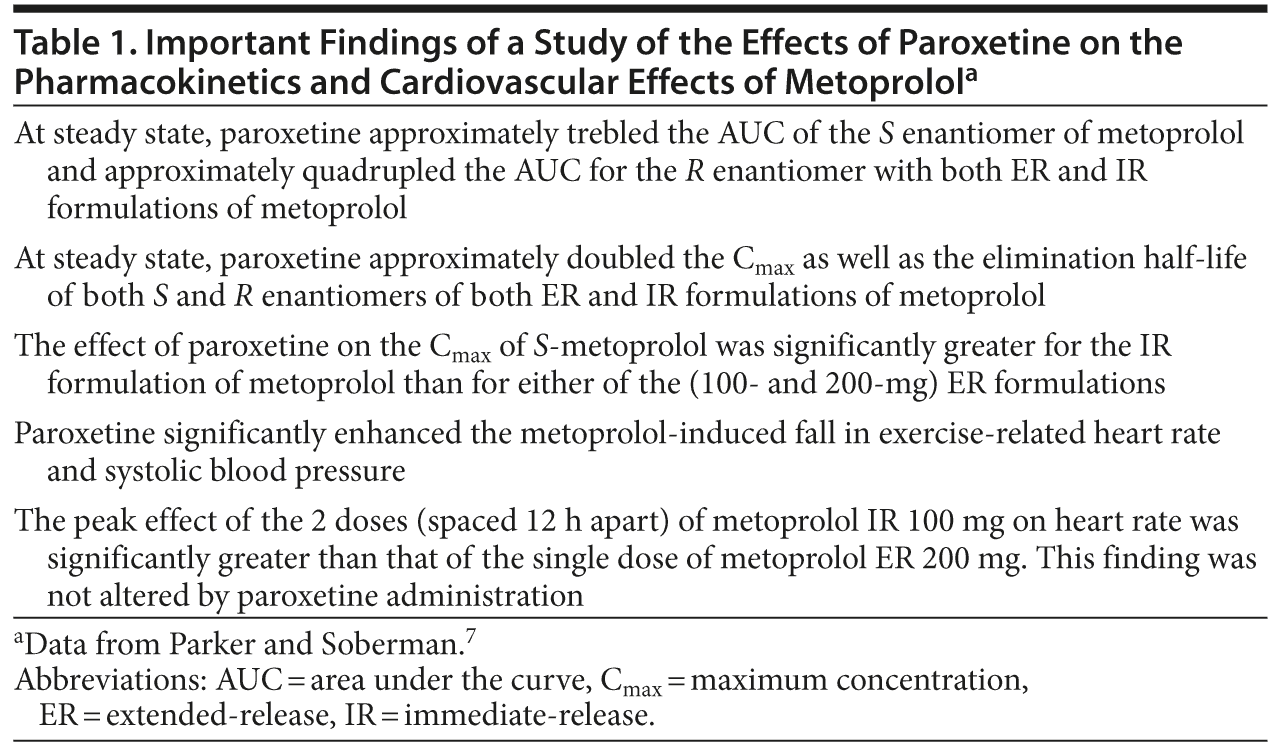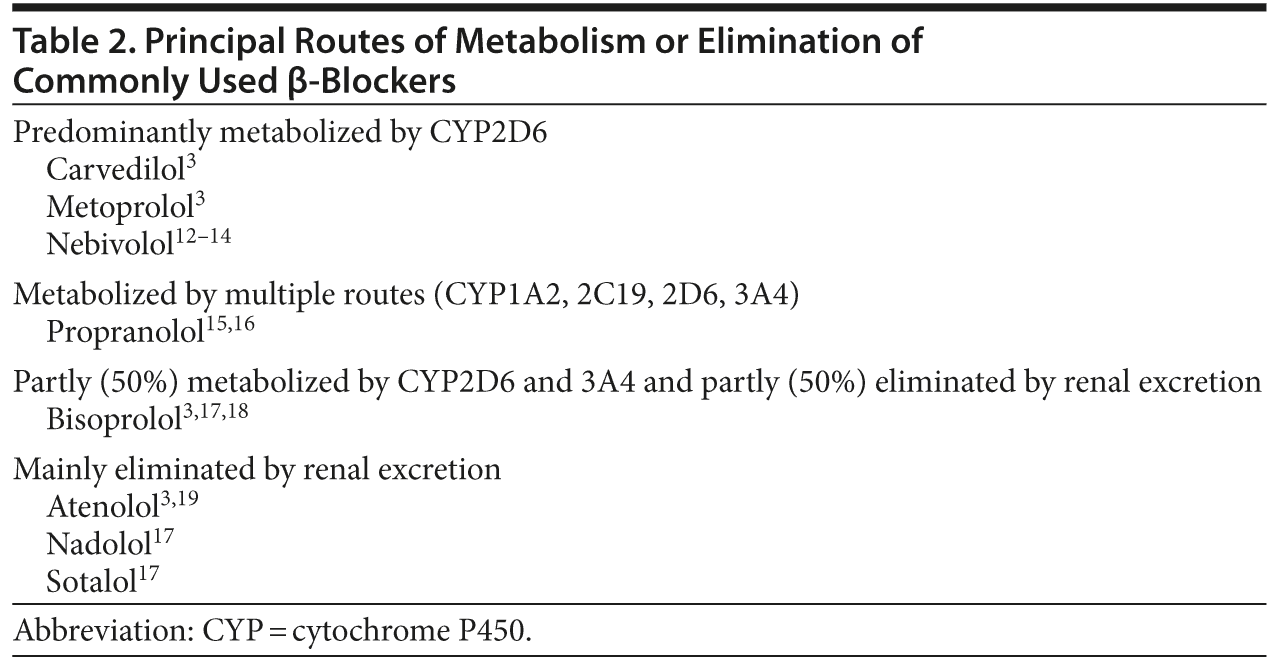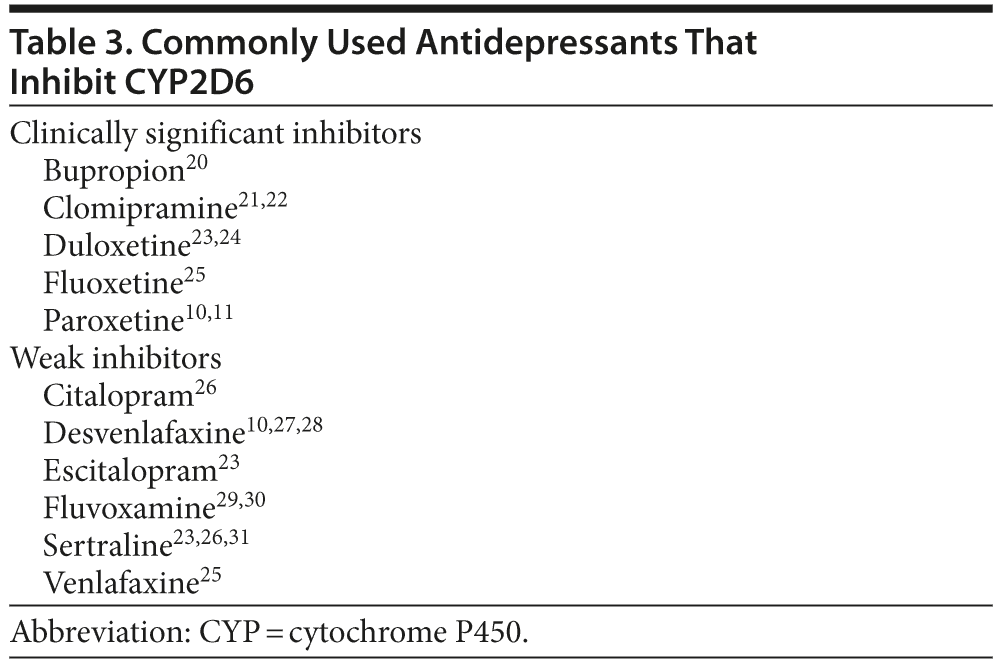b-Blockers are prescribed for several indications, including ischemic heart disease, hypertension, heart failure, anxiety, migraine, and essential tremor. Some patients receiving b-blockers for 1 or more of these indications may also require treatment with an antidepressant, such as for comorbid depression. Some antidepressants inhibit the metabolism of some b-blockers; for example, fluoxetine, paroxetine, duloxetine, and bupropion can inhibit cytochrome P450 2D6 and thereby increase the levels of metoprolol, carvedilol, and nebivolol. This pharmacokinetic drug interaction can result in clinically significant bradycardia and hypotension, heart block, or other dose-dependent adverse effects in vulnerable patients. The interaction can be avoided by prescribing an antidepressant that does not affect the metabolism of the b-blocker in use, or by prescribing a b-blocker that is not metabolized by the antidepressant in use. If the interaction is unavoidable, the dose of the b-blocker can be down-titrated using heart rate and blood pressure as a clinical guide.

- Some antidepressants inhibit the metabolism of some β-blockers.
- Bradycardia and hypotension, heart block, or other dose-dependent adverse effects may occur in vulnerable patients as a result of these interactions.
- Strategies include prescribing an antidepressant that does not affect the metabolism of the β-blocker in use, or prescribing a β-blocker that is not metabolized by the antidepressant in use.
- If the interaction is unavoidable, the β-blocker dose can be down-titrated using heart rate and blood pressure as a guide.
Clinical Problem
Last month’s column examined potential selective serotonin reuptake inhibitor (SSRI) interactions with antiplatelet drugs (aspirin, clopidogrel) in a hypothetical 67-year-old man with major depressive disorder comorbid with ischemic heart disease (IHD).1 This month, we continue the discussion on possible concerns associated with using an antidepressant to treat depression in this patient.
Patients with IHD commonly receive β-blocker drugs. β-Blockers are also used in the treatment of hypertension, heart failure, anxiety, migraine, essential tremor, and other conditions. Commonly used β-blockers include atenolol, metoprolol, nebivolol, carvedilol, bisoprolol, and propranolol.2-5 Many antidepressants inhibit the cytochrome P450 (CYP) enzymes that metabolize certain β-blocker drugs. If the metabolism of β-blockers is inhibited, their peak blood level and half-life will increase, resulting in an increase in dose-dependent adverse effects. Prominent among these adverse effects are bradycardia, heart block, hypotension, and loss of cardioselectivity associated with an increased risk of bronchoconstriction and altered glucose homeostasis.6,7
Drug Interaction: Paroxetine and Metoprolol
Several studies illustrate the interaction between paroxetine, a commonly used SSRI, and metoprolol, a commonly used β-blocker. For example, in a randomized, open-label, 3-way crossover study, Parker and Soberman7 examined how paroxetine affects the pharmacokinetics and cardiovascular effects of metoprolol. This study was conducted in 15 healthy volunteers in whom genotyping confirmed the presence of at least 1 active CYP2D6 allele; thus, no subject was a CYP2D6 poor metabolizer.
On the first day of each of the 3 phases of the study, these volunteers received a single dose of metoprolol extended-release (ER) 100 mg, a single dose of metoprolol ER 200 mg, or 2 doses of metoprolol immediate-release (IR) 100 mg administered 12 hours apart. The volunteers then received paroxetine 20 mg/d on days 2-8. Finally, the same metoprolol formulation was administered on day 8. In the 3 phases of the study, volunteers rotated through the 3 different formulations of metoprolol with a 14-day washout between the phases.
Important findings of the study7 are presented in Table 1. In sum, paroxetine substantially raised the peak blood level of and the exposure to metoprolol, resulting in heightened metoprolol-induced fall in exercise-related heart rate and systolic blood pressure. Paroxetine had a greater effect on IR than on ER metoprolol.
Similar findings have been reported by other investigators. For example, in a pharmacokinetic study conducted in healthy volunteers, Stout et al8 showed that paroxetine increased the area under the curve (AUC) of the S and R enantiomers of metoprolol by 4- and 5-fold, respectively, with the IR formulation and by 3- and 4-fold, respectively, with the ER formulation. Goryachkina et al9 also reported the inhibition of metoprolol metabolism by paroxetine. These findings suggest that patients receiving metoprolol should receive lower doses of the drug if they are also treated with paroxetine; the actual dose of metoprolol can be determined by titration on the basis of its clinically measured cardiovascular effects. It may also be safer for patients to receive metoprolol ER than metoprolol IR when paroxetine and metoprolol are prescribed together.
Mechanism of the Interaction Between Paroxetine and Metoprolol
Paroxetine is a potent inhibitor of CYP2D6,10,11 the enzyme that plays a major role in the metabolism of metoprolol.3 This explains why paroxetine increases pharmacokinetic indices of exposure to metoprolol and, hence, the cardiovascular effects of metoprolol.
Other Antidepressants and Other β-Blockers
The interaction between antidepressants and β-blockers can be anticipated if one knows how individual β-blockers are metabolized or eliminated (Table 2) and the effects of individual antidepressants on the CYP enzyme system (Table 3). It is apparent that most of the commonly used β-blockers are either metabolized by CYP2D6 or eliminated by renal excretion3,12-19; thus, an awareness of which commonly used antidepressants significantly inhibit CYP2D610,11,20-25 will warn clinicians about the risk of a potential drug interaction. Table 3 also lists antidepressants that are mild inhibitors of CYP2D610,23,25,26,29-31; these are probably associated with lower risk of CYP2D6 drug interactions at usual clinical doses.
There is evidence to show that the data in Tables 2 and 3 can reasonably be extrapolated to real-life practice. For example, in a pharmacokinetic study23 in healthy human volunteers, duloxetine, escitalopram, and sertraline all increased exposure to metoprolol: whereas sertraline increased the metoprolol AUC by over 50%, escitalopram nearly doubled the AUC, and duloxetine nearly trebled it. Furthermore, whereas sertraline increased the maximum concentration (Cmax) of metoprolol by 38%, the Cmax was doubled by both escitalopram and duloxetine. Increases in Cmax and AUC both predict an increased likelihood of physiologic and adverse effects of a drug.
In other reports and studies, paroxetine doubled the AUC of carvedilol in healthy volunteers,32 and fluoxetine increased the exposure to metoprolol33 and nebivolol.14
Propranolol is mainly metabolized by CYP1A2 and 2D6, but other CYP enzymes (including CYP2C19 and 3A4) also participate in its breakdown.15,16 An important implication here is that if only 1 enzyme is inhibited (eg, CYP2D6, by paroxetine), the activity of the remaining enzymes will help ensure that propranolol pharmacokinetics are not excessively impacted. However, fluvoxamine, which potently inhibits CYP1A230 and 2C1934 and less potently inhibits CYP2D6 and 3A4,29,30 can be expected to increase levels of propranolol35 and hence its biological effects.
Are the Interactions Clinically Significant?
Single-dose pharmacokinetic studies in healthy volunteers may not identify significant cardiovascular changes associated with the drug interactions described. For example, Stout et al32 found that although paroxetine doubled the AUC of carvedilol in healthy volunteers, there were no clinically significant changes in heart rate, blood pressure, or PR interval. However, adverse events have indeed been reported after chronic dosing in patients.
About 2 decades ago, Walley et al33 reported that a depressed 54-year-old man receiving metoprolol 100 mg/d for IHD developed fatigue and severe bradycardia within 2 days of starting treatment with fluoxetine: his heart rate dropped from 64 bpm to 36 bpm. His heart rate returned to normal 5 days after fluoxetine was withdrawn. Metoprolol was replaced by sotalol, and fluoxetine was reintroduced; there was no recurrence of bradycardia. Severe sinus bradycardia was also reported by McCollum et al36 after bupropion was added to ongoing treatment with metoprolol.
Onalan et al37 reported a 63-year-old woman who developed complete atrioventricular heart block 15 days after the addition of metoprolol (50 mg/d) to ongoing treatment with paroxetine (20 mg/d). Metoprolol was discontinued, and paroxetine treatment was also stopped several days later. After 5 further days, the heart block spontaneously resolved. No bradyarrhythmia was observed after challenge with similar doses of either metoprolol or paroxetine alone. The patient remained free of bradyarrhythmia at 2- and 3-year follow-up.
Goryachkina et al9 studied 17 patients with acute myocardial infarction, all of whom were receiving metoprolol as a routine part of their therapy and paroxetine for depression. The authors found that paroxetine quadrupled the metoprolol AUC. In 2 (12%) of the patients, the dose of metoprolol had to be reduced because of excessive bradycardia and severe orthostatic hypotension. A quick reference to Tables 2 and 3 will explain why the interactions described in this and earlier sections occurred.
There is a theoretical risk that severe bradycardia and hypotension associated with raised levels of β-blockers may result in falls and fractures in the elderly. Although this does not appear to be a problem at the population level,38,39 risk in individual vulnerable patients cannot be ruled out.
Patients vulnerable to adverse effects associated with raised levels of β-blockers include the elderly, those with poor left ventricular systolic function, those with asthma or other bronchospastic disease, and those with unrecognized cardiac conduction problems.7
Action Points
Reference to Tables 2 and 3 can help clinicians anticipate potential pharmacokinetic drug interactions between antidepressant drugs and β-blockers. Clinicians may wish to avoid prescribing an antidepressant that risks an interaction, or, if they do prescribe such an antidepressant, they would need to down-titrate the dose of the β-blocker (that the patient is receiving) using the patient’s heart rate and blood pressure as a guide.
Additional Notes
The effects of CYP2D6 inhibitors (Table 3) on the β-blockers that are metabolized by this enzyme (Table 2) are most apparent in persons who are CYP2D6 extensive metabolizers; that is, the majority of the population. This is because CYP2D6 poor metabolizers already have the equivalent of an inhibited form of the enzyme. CYP2D6 poor metabolizers comprise about 0%-14% of the population, depending on geographical origin.11
Carvedilol and bisoprolol are P-glycoprotein substrates,3,40 and paroxetine and sertraline both inhibit P-glycoprotein.41 However, the impact of paroxetine or sertraline use on the transport of carvedilol and bisoprolol is presently unclear.
Interactions With Fruit Juice
Clinicians who have read up to this point may also be interested to learn that fruit juice can reduce the absorption of some β-blockers. For example, orange juice42,43 and apple juice44 have both been reported to reduce the oral bioavailability of atenolol.
J Clin Psychiatry 2013;74(1):e75-e78 (doi:10.4088/JCP.12f08323)
© Copyright 2013 Physicians Postgraduate Press, Inc.
 Each month in his online column, Dr Andrade considers theoretical and practical ideas in clinical psychopharmacology with a view to update the knowledge and skills of medical practitioners who treat patients with psychiatric conditions.
Each month in his online column, Dr Andrade considers theoretical and practical ideas in clinical psychopharmacology with a view to update the knowledge and skills of medical practitioners who treat patients with psychiatric conditions.
Department of Clinical Psychopharmacology and Neurotoxicology, National Institute of Mental Health and Neurosciences, Bangalore, India ([email protected]).
Financial disclosure and more about Dr Andrade.
REFERENCES
1. Andrade C. Drug interactions in the treatment of depression in patients with ischemic heart disease. J Clin Psychiatry. 2012;73(12):e1475-e1477.
2. Emilien G, Maloteaux JM. Current therapeutic uses and potential of beta-adrenoceptor agonists and antagonists. Eur J Clin Pharmacol. 1998;53(6):389-404. PubMed doi:10.1007/s002280050399
3. Brodde OE, Kroemer HK. Drug-drug interactions of beta-adrenoceptor blockers. Arzneimittelforschung. 2003;53(12):814-822. PubMed
4. Münzel T, Gori T. Nebivolol: the somewhat-different beta-adrenergic receptor blocker. J Am Coll Cardiol. 2009;54(16):1491-1499. PubMed
5. DiNicolantonio JJ, Hackam DG. Carvedilol: a third-generation β-blocker should be a first-choice β-blocker. Expert Rev Cardiovasc Ther. 2012;10(1):13-25. PubMed doi:10.1586/erc.11.166
6. Erdmann E. Safety and tolerability of beta-blockers: prejudices & reality. Indian Heart J. 2010;62(2):132-135. PubMed
7. Parker RB, Soberman JE. Effects of paroxetine on the pharmacokinetics and pharmacodynamics of immediate-release and extended-release metoprolol. Pharmacotherapy. 2011;31(7):630-641. PubMed doi:10.1592/phco.31.7.630
8. Stout SM, Nielsen J, Welage LS, et al. Influence of metoprolol dosage release formulation on the pharmacokinetic drug interaction with paroxetine. J Clin Pharmacol. 2011;51(3):389-396. PubMed doi:10.1177/0091270010365559
9. Goryachkina K, Burbello A, Boldueva S, et al. Inhibition of metoprolol metabolism and potentiation of its effects by paroxetine in routinely treated patients with acute myocardial infarction (AMI). Eur J Clin Pharmacol. 2008;64(3):275-282. PubMed doi:10.1007/s00228-007-0404-3
10. Nichols AI, Fatato P, Shenouda M, et al. The effects of desvenlafaxine and paroxetine on the pharmacokinetics of the cytochrome P450 2D6 substrate desipramine in healthy adults. J Clin Pharmacol. 2009;49(2):219-228. PubMed doi:10.1177/0091270008326716
11. Zhou S-F, Liu J-P, Chowbay B. Polymorphism of human cytochrome P450 enzymes and its clinical impact. Drug Metab Rev. 2009;41(2):89-295. PubMed doi:10.1080/03602530902843483
12. Lefebvre J, Poirier L, Poirier P, et al. The influence of CYP2D6 phenotype on the clinical response of nebivolol in patients with essential hypertension. Br J Clin Pharmacol. 2007;63(5):575-582. PubMed doi:10.1111/j.1365-2125.2006.02796.x
13. Prisant LM. Nebivolol: pharmacologic profile of an ultraselective, vasodilatory beta1-blocker. J Clin Pharmacol. 2008;48(2):225-239. PubMed doi:10.1177/0091270007310378
14. Lindamood C, Ortiz S, Shaw A, et al. Effects of commonly administered agents and genetics on nebivolol pharmacokinetics: drug-drug interaction studies. J Clin Pharmacol. 2011;51(4):575-585. PubMed doi:10.1177/0091270010370846
15. Yoshimoto K, Echizen H, Chiba K, et al. Identification of human CYP isoforms involved in the metabolism of propranolol enantiomers—N-desisopropylation is mediated mainly by CYP1A2. Br J Clin Pharmacol. 1995;39(4):421-431. PubMed doi:10.1111/j.1365-2125.1995.tb04472.x
16. Johnson JA, Herring VL, Wolfe MS, et al. CYP1A2 and CYP2D6 4-hydroxylate propranolol and both reactions exhibit racial differences. J Pharmacol Exp Ther. 2000;294(3):1099-1105. PubMed
17. McDevitt DG. Comparison of pharmacokinetic properties of β-adrenoceptor blocking drugs. Eur Heart J. 1987;8(suppl M):9-14. PubMed doi:10.1093/eurheartj/8.suppl_M.9
18. Horikiri Y, Suzuki T, Mizobe M. Pharmacokinetics and metabolism of bisoprolol enantiomers in humans. J Pharm Sci. 1998;87(3):289-294. PubMed doi:10.1021/js970316d
19. Kirch W, Görg KG. Clinical pharmacokinetics of atenolol—a review. Eur J Drug Metab Pharmacokinet. 1982;7(2):81-91. PubMed doi:10.1007/BF03188723
20. Kotlyar M, Brauer LH, Tracy TS, et al. Inhibition of CYP2D6 activity by bupropion. J Clin Psychopharmacol. 2005;25(3):226-229. PubMed doi:10.1097/01.jcp.0000162805.46453.e3
21. Lamard L, Pérault MC, Bouquet S, et al. Cytochrome p450 IID6, its role in psychopharmacology [in French]. Ann Med Psychol (Paris). 1995;153(2):140-143. PubMed
22. Vandel P, Haffen E, Nezelof S, et al. Clomipramine, fluoxetine and CYP2D6 metabolic capacity in depressed patients. Hum Psychopharmacol. 2004;19(5):293-298. PubMed doi:10.1002/hup.598
23. Preskorn SH, Greenblatt DJ, Flockhart D, et al. Comparison of duloxetine, escitalopram, and sertraline effects on cytochrome P450 2D6 function in healthy volunteers. J Clin Psychopharmacol. 2007;27(1):28-34. PubMed doi:10.1097/00004714-200702000-00005
24. Knadler MP, Lobo E, Chappell J, et al. Duloxetine: clinical pharmacokinetics and drug interactions. Clin Pharmacokinet. 2011;50(5):281-294. PubMed doi:10.2165/11539240-000000000-00000
25. Amchin J, Ereshefsky L, Zarycranski W, et al. Effect of venlafaxine versus fluoxetine on metabolism of dextromethorphan, a CYP2D6 probe. J Clin Pharmacol. 2001;41(4):443-451. PubMed doi:10.1177/00912700122010159
26. Preskorn SH. Clinically relevant pharmacology of selective serotonin reuptake inhibitors. an overview with emphasis on pharmacokinetics and effects on oxidative drug metabolism. Clin Pharmacokinet. 1997;32(suppl 1):1-21. PubMed doi:10.2165/00003088-199700321-00003
27. Patroneva A, Connolly SM, Fatato P, et al. An assessment of drug-drug interactions: the effect of desvenlafaxine and duloxetine on the pharmacokinetics of the CYP2D6 probe desipramine in healthy subjects. Drug Metab Dispos. 2008;36(12):2484-2491. PubMed doi:10.1124/dmd.108.021527
28. Preskorn SH, Nichols AI, Paul J, et al. Effect of desvenlafaxine on the cytochrome P450 2D6 enzyme system. J Psychiatr Pract. 2008;14(6):368-378. PubMed doi:10.1097/01.pra.0000341891.43501.6b
29. van Harten J. Overview of the pharmacokinetics of fluvoxamine. Clin Pharmacokinet. 1995;29(suppl 1):1-9. PubMed doi:10.2165/00003088-199500291-00003
30. Br׸sen K. Differences in interactions of SSRIs. Int Clin Psychopharmacol. 1998;13(suppl 5):S45-S47. PubMed doi:10.1097/00004850-199809005-00009
31. Solai LK, Mulsant BH, Pollock BG, et al. Effect of sertraline on plasma nortriptyline levels in depressed elderly. J Clin Psychiatry. 1997;58(10):440-443. PubMed doi:10.4088/JCP.v58n1006
32. Stout SM, Nielsen J, Bleske BE, et al. The impact of paroxetine coadministration on stereospecific carvedilol pharmacokinetics. J Cardiovasc Pharmacol Ther. 2010;15(4):373-379. PubMed doi:10.1177/1074248410372926
33. Walley T, Pirmohamed M, Proudlove C, et al. Interaction of metoprolol and fluoxetine. Lancet. 1993;341(8850):967-968. PubMed doi:10.1016/0140-6736(93)91265-N
34. Yasui-Furukori N, Takahata T, Nakagami T, et al. Different inhibitory effect of fluvoxamine on omeprazole metabolism between CYP2C19 genotypes. Br J Clin Pharmacol. 2004;57(4):487-494. PubMed doi:10.1111/j.1365-2125.2003.02047.x
35. Perucca E, Gatti G, Spina E. Clinical pharmacokinetics of fluvoxamine. Clin Pharmacokinet. 1994;27(3):175-190. PubMed doi:10.2165/00003088-199427030-00002
36. McCollum DL, Greene JL, McGuire DK. Severe sinus bradycardia after initiation of bupropion therapy: a probable drug-drug interaction with metoprolol. Cardiovasc Drugs Ther. 2004;18(4):329-330. PubMed doi:10.1023/B:CARD.0000041254.15807.98
37. Onalan O, Cumurcu BE, Bekar L. Complete atrioventricular block associated with concomitant use of metoprolol and paroxetine. Mayo Clin Proc. 2008;83(5):595-599. PubMed
38. Woolcott JC, Richardson KJ, Wiens MO, et al. Meta-analysis of the impact of 9 medication classes on falls in elderly persons. Arch Intern Med. 2009;169(21):1952-1960. PubMed doi:10.1001/archinternmed.2009.357
39. Gribbin J, Hubbard R, Gladman JR, et al. Risk of falls associated with antihypertensive medication: population-based case-control study. Age Ageing. 2010;39(5):592-597. doi:10.1093/ageing/afq092 PubMed
40. Bachmakov I, Werner U, Endress B, et al. Characterization of β-adrenoceptor antagonists as substrates and inhibitors of the drug transporter P-glycoprotein. Fundam Clin Pharmacol. 2006;20(3):273-282. PubMed doi:10.1111/j.1472-8206.2006.00408.x
41. Weiss J, Dormann SM, Martin-Facklam M, et al. Inhibition of P-glycoprotein by newer antidepressants. J Pharmacol Exp Ther. 2003;305(1):197-204. PubMed doi:10.1124/jpet.102.046532
42. Lilja JJ, Raaska K, Neuvonen PJ. Effects of orange juice on the pharmacokinetics of atenolol. Eur J Clin Pharmacol. 2005;61(5-6):337-340. PubMed doi:10.1007/s00228-005-0930-9
43. Bailey DG. Fruit juice inhibition of uptake transport: a new type of food-drug interaction. Br J Clin Pharmacol. 2010;70(5):645-655. PubMed doi:10.1111/j.1365-2125.2010.03722.x
44. Jeon H, Jang IJ, Lee S, et al. Apple juice greatly reduces systemic exposure to atenolol [published online ahead of print May 11, 2012]. Br J Clin Pharmacol. doi:10.1111/j.1365-2125.2012.04324.x. PubMed
This PDF is free for all visitors!








